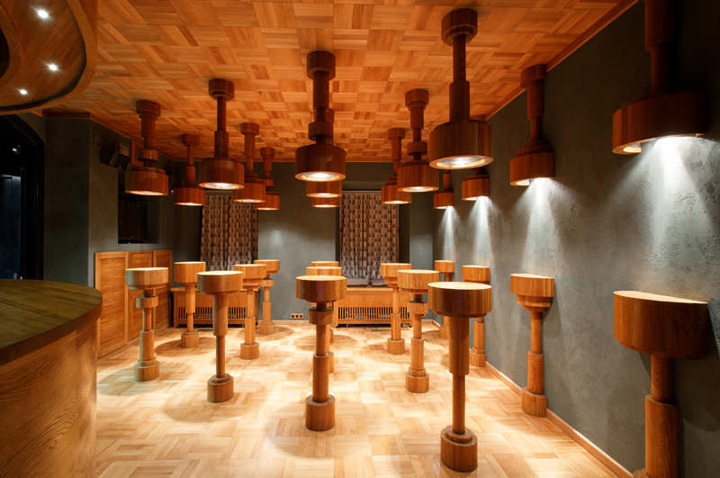


The construction was built in the 18th century, but it was completely burnt out in Moscow Fire in 1812. Only stone part of it escaped destruction. The wooden part of it was restored at the end of the 19thcentury. A complete restoration was finished only in 2011 together with renovation of the inside rooms of the building.

Floor areas of all two-level premises make up nearly 300sq. m. Arias are as following: on the first floor there are entrances, cloak rooms, WC. A stair case leads to a second floor where three halls linked to each other are located. These halls are: main bar, small bar and chill-out

Three main halls are located in two separate buildings and have different ceiling height, different year of constructing and different architectural style. Two historically interesting fire places in the very center motivated thedesigner’s solution about the main hall.

As the part of premises is historical object, a number of restrictions were put on design-project. Not only fire places which were fullyrestored, no change was allowed about such objects as color of walls, parquet design, shape of cornice, historicalbricks.

The necessity to keep the image of the main hall and absence of other restrictions as well as customer’s wish-all these indicated our approach to search art image. As a result quite free way of interior finish without focusing on special style was agreed.

In whole classical decorative style is kept but it is interfered in a delicate way with two allogenic objects as if they are the parts of Gallery Art exhibition. Or implementing new modern shapes, approaches and materials in the historical context of interior.

For example, WC zones located on the socle floor in the premises with arched ceiling of the 18th century. Behind intent ally rough and poor front assembled of planks with big illuminated chinks there are ultra-modern cubicles made of snow white Corian. Inside the cubicles when the doors are closed cut less trim work makes you feel vacuum and weightless space

Similar method was implemented in the Main Bar. Between two historical fireplaces finished with old ceramic tile, there stands bar counter, which is an absolute outsider for historically asserted crystal shape, as if it is an item taken from Modern Arts Museum.

DJ counterbeing exclusively a subject of modern designing culture is paneled with ornaments chiseled from the woods bearing decorative elements used for enrichments of fireplaces. The theme of modern interpretation of classical elements is also implemented in the small bar called “rjumochnaya”(a jigger) and in the chill out area.

Traditional materials used for finishing “rjumochnaya”(a jigger) contrast with interpretation of how and where they are used ,e.g.the bar ceiling is parqueted literary in the same way as floor while the lightning fittings above the tables are made of wood the shape of which replicates the shape of tables which creates the feeling of weightlessness and confusion of inversely space reflection.

Chill out is designed to similar principles. There is no surface boundary that is they are made of the same material-concreteslaps elbowing on different levels. Tectonic concrete slabs resemble classical Roman architecture. Some elements are exact replicas of fragments of some orders, cornices and friezes. The intervals between them are faced with steel metal striae. Stair case was also changed dramatically: conventional parallel flights of steps were transformed into composite directed upward.

Lower part of dome to which a stair case is directed is shaped as huge lightning fitting which illuminates the under domespace. Lightning fittings are made of 600 sewer pipes of various diameters. Inside each of them a LED illumination is set.

Probably one of the main tasks for project designerswas to create warm and comfortable atmosphere of home party rather thanthe image of commercial public place. All attributable elements of public interiors such as identical furniture, widely spread elements of finishing were excluded initially.

Each of the zones has its own architectural solution. The furniture is assembled from different factories and the collections literary fill in the space one by one. As if they are they are the items of private collection.

Similar idea was implemented for finishing walls, floor and ceiling. For most part each type of material is unique and inimitable. E.g. ceramic tile in women’s rooms are painted by hand. The walls are made as decorative stucco feeling as aging already and not new surface which sustains images depending on each room style. Construction materials for ceiling is also varying from classical painted with cornices to chandelier made of sewer pipes which form strange dynamic shape under dome above the staircase.

Illuminating equipment is also rare. Some of them are madefrom scratch designs and represent inimitable elements, e.g. a group of lightning fittings illuminating bar counter was fixed to metal list which is a copy of a bar counter surface. Thus a bar and a group of chandeliers make a solid composition.
Photographs: Alexey Knyazev
Designed by Peter Kostelov, Alexey Rozenberg, Anton Grechko




http://www.archdaily.com/208997/bar-studio-kluchi-peter-kostelov/





























